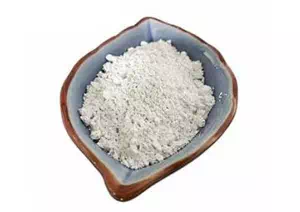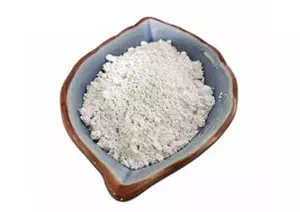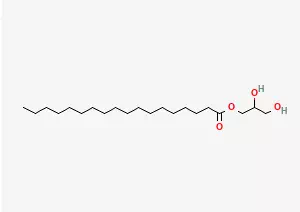All Categories



glyceryl monostearate CAS 11099-07-3, glyceryl monostearate, CAS 11099-07-3
In the wonderful world of chemistry, monostearic acid glycerol exhibits its unique physical properties. It is a waxy solid with a milky white appearance. This unique color and texture make it highly recognizable among many chemical substances. When placed in a suitable solvent environment, it can dissolve smoothly in two common organic solvents, ethanol and ether.
CAS : 11099-07-3
Formula : C18H36O2.xC3H8O3
Mol. wt. : 358.56
EINECS : 234-325-6
Chemical Name | Glyceryl Monostearate |
Other Name | Glyceryl stearate; 1,2,3-PROPANETRIOL 1-OCTADECANOATE |
CAS | 11099-07-3 |
EINECS | 234-325-6 |
Type | Cosmetic raw materials; Organic raw materials |
Molecular Formula | C18H36O2.xC3H8O3 |
Molecular Weight | 358.56 |
Melting point | 78-81 °C |
refractive index | 1.4385 (589.3 nm 80℃) |
storage temp. | −20°C |
Odor | at 100.00?%. bland fatty waxy |
LogP | 8.216 (est) |

In the wonderful world of chemistry, monostearic acid glycerol exhibits its unique physical properties. It is a waxy solid with a milky white appearance. This unique color and texture make it highly recognizable among many chemical substances. When placed in a suitable solvent environment, it can dissolve smoothly in two common organic solvents, ethanol and ether. This solubility characteristic provides convenient conditions for it in various chemical reactions and practical applications.
From the perspective of chemical properties, monostearic acid glycerol is an extremely special nonionic surfactant. Its uniqueness lies in the fact that it has both hydrophilic and lipophilic genes in its molecular structure. This special structure endows it with a series of important functional characteristics. Among them, the wetting function enables it to spread evenly on the surface of the object, enhancing the affinity of the liquid for the solid surface; The emulsification function enables it to effectively mix two immiscible liquids to form a stable emulsion. The foaming function enables it to generate abundant foam in certain specific scenarios, such as washing and cleaning, thereby achieving a better cleaning effect.
Further exploration of the stereochemical structure of monostearic acid glycerol reveals that it has three stereoisomers, namely 1-monostearic acid glycerol and 2-monostearic acid glycerol enantiomers. Due to their close chemical structure and high similarity in many physical and chemical properties, in practical situations, they rarely appear in a single pure form but usually exist in various systems in the form of mixtures. The existence form of this mixture, although it increases the difficulty of its research and separation to a certain extent, also provides more abundant and diverse options for some specific application scenarios.
In the industrial production process, especially in the commercial materials used in the food field, there is a mature and large-scale method for the preparation of glycerol monostearate. Specifically, it is produced through the glycerol hydrolysis reaction that occurs between triglycerides (these triglycerides have a wide range of sources, either natural oils extracted from plants or obtained from animal fats) and glycerol. This reaction process has been meticulously controlled and optimized to ensure that glycerol monostearate products that meet food-grade quality standards and application requirements can be obtained.
It is worth mentioning that monostearic acid glycerol also plays an important role in organisms. It is a product of fat breakdown by pancreatic lipase, which means that in the normal physiological metabolic process of the human body, monostearic acid glycerol is a natural intermediate product in the process of fat digestion and absorption, and is widely present inside the human body. Furthermore, in some seed oils, although the content of monostearates is relatively low, their presence also reflects the diversity of the distribution and existence forms of monostearate glycerol in nature.

GMS, namely glycerol monostearate, is a food additive widely used in the food industry. It plays an important role in many fields. It can not only be used as a thickener, but also increase the viscosity of food, making it have a more suitable texture and taste. It can also act as an emulsifier, effectively and evenly mixing immiscible substances such as oil and water together to form a stable emulsion system, playing a key role in some oil-water mixed sauces and other products. At the same time, it is also an anti-caking agent, which can prevent food from caking due to factors such as moisture and compression during storage and transportation, maintaining a loose state of the food. For instance, some powdered food additives often use it to prevent caking. In addition, it also has the function of a preservative. By inhibiting the growth and reproduction of microorganisms, it extends the shelf life of food and ensures the safety and quality stability of food during its shelf life.
In the field of chemical engineering, GMS can serve as an emulsifier for oils, waxes and solvents, helping these substances blend and disperse better. For instance, it plays a role in certain oil processing or solvent blending processes. For hygroscopic powders, GMS can act as a protective coating, wrapping the hygroscopic powder and reducing its contact with external moisture, thereby preventing the powder from caking or deteriorating due to moisture absorption. This is very useful in the storage of some powdered raw materials that need to be kept dry. In terms of pharmaceutical preparations, GMS can be used as a curing agent to enable better shaping of drugs during the preparation process and ensure the stability of drug dosage forms. At the same time, it can also serve as a controlled-release agent, precisely controlling the release rate of the drug in the body and enhancing the efficacy and safety of the drug. In addition, during the resin processing, GMS can act as a lubricant to reduce the friction between resins, making the resin processing process smoother and enhancing production efficiency and product quality.
In the fields of cosmetics and hair care products, GMS also has important applications. It can help cosmetics adhere better to the skin, enhancing their covering power and durability. In hair care products, it can improve the texture of hair, making it smoother and shinier. At the same time, it can also play a certain moisturizing role, preventing hair from being damaged due to dryness.
The application of GMS in the food industry is particularly prominent, especially in the field of baked goods. When making baked goods such as bread, cakes and biscuits, adding an appropriate amount of GMS can add a unique "texture" to the food, making the internal structure of the baked goods more delicate and soft, and the external taste more crispy. In the production of ice cream and fresh cream, GMS can to a certain extent optimize the taste of the products, making them smoother, reducing the formation of ice crystals, and enhancing the consumption experience of consumers. Moreover, sometimes GMS is also used as a preservative for bread. By inhibiting the growth of microorganisms in the bread, it extends the bread's shelf life and maintains its freshness and taste.
In addition, glycerol monostearate can also be used as a plastic additive. During the plastic processing, GMS, as an antistatic and anti-fogging agent, can effectively prevent the plastic surface from attracting dust due to static electricity. At the same time, it can also prevent the plastic from fogging in a humid environment, which would affect the transparency and appearance of the plastic. This application is very common in food packaging because food packaging has high requirements for hygiene and appearance. The anti-static and anti-fog performance of GMS can ensure the quality and safety of food packaging, extend the shelf life of food, and also enhance the overall aesthetic appeal of food packaging.
* Prompt reply and 24 hours online, professional team to provide best price and high quality product.
* Sample testing support.
* Every batch of products will be tested to ensureits quality.
*The packing also can be according the customers` requirment.
*Any inquiries will be replied within 24 hours.
*we provide Commerical Invoice, Packing List, Bill of loading, COA , Health certificate and Origin certificate. If your markets have any special requirements, let us know.